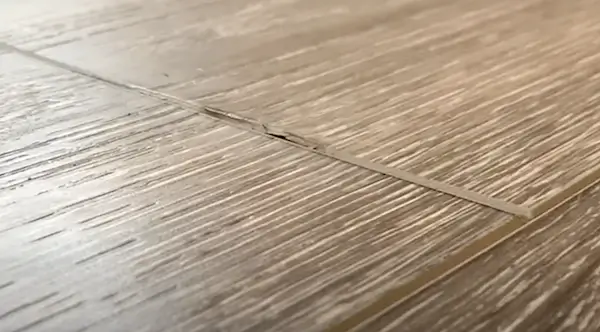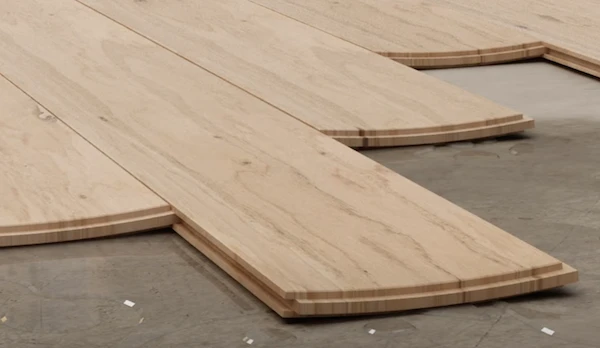
It may happen sometimes that your laminate planks start lifting. The reasons for this undesirable occurrence are plenty, some of which being improper installation, uneven subfloor and excessive moisture.
While it may seem a daunting task to fix laminate flooring, our professional tips on how to do the repairs will come in handy for you.
First, let’s take a sneak previews as to why your laminate floors may be warping and lifting:
❶ Uneven Sub Floor
❷ Lack of Expansion Gap
❸ Excessive Moisture & Humidity
❹ Excessive Heat
“Persistence is key when dealing with laminate flooring. If it’s lifting, it’s usually due to an issue with moisture or uneven subfloor. Depending on the severity, you might consider a bit of DIY or professional help. My advice would be to always assess and address the root cause first. Don’t just treat the symptom. It requires patience and attention, but the results are invaluable.”
Zephyr Howard, Flooring Specialist
Why Is Laminate Flooring Lifting?
As stated, there are several reasons for laminate boards to be lifting. Luckily, only segments of your floor will lift and not the entire area. However, it’s important to address these issues promptly to prevent further damage. One common problem is when laminate flooring doesn’t lock properly, which can lead to lifting.
Whatever the cause might be, the planks will most likely look curved, generating a wavy pattern. In extreme cases, they will completely detach from the subfloor.

An Uneven Subfloor
Naturally, if the laminate planks have been installed on surface that’s not flat, they are likely to lift. Proper laminate instalment involves positioning boards over an even subfloor, which is a uniform area over the entire room with no bumps so the board can lay true.
You can use a leveler to know if the floor is uneven. Make sure to take reads from all sides of the room, including corners. If you are getting bad reads, then you might have a structural problem. This is especially important when installing laminate flooring on uneven concrete, which requires special preparation.
If this is not the case, laminate boards are likely to move around, resulting in floating and lifted floor.
Expansion Gaps Not Taken Into Consideration
Leaving expansion gaps around the margins of the flooring allows room for the planks to contract and expand as room conditions change (such as temperature and humidity levels).
If there is no expansion gap, your laminate flooring has no where to go, and are more likely to start lifting in future. Wood can expand or contract with a 7% change in temperature approximately.
Excess Moisture & Humidity
It is not news that any type of floor, including laminate floor, vinyl flooring and hardwood floors, are prone to moisture damage.

Whether the moisture source is spilled water, water leaks, or cleaning laminate floors using too much water, it will sooner or later cause damage. The boards will start swelling and eventually lift up.
That said, follow sound logic and don’t install new laminate floors in your kitchen or bathroom since these rooms are way too humid. You can consider other materials like ceramic or vinyl which can take more humidity without changing shape.
Excess Heating
Like moisture damage, excessive heat can cause laminate flooring to swell and lift, especially if your heating source is directly heating the floor beneath.
This is likely to happen if you are using short-wave infrared heating sources.
To safeguard against this, make sure your heater is elevated from the floor and not directly heating it.
Don’t install laminate floorboards in the kitchen as the heat from the stove is bound to make the floor lift up. Install a ceramic tile instead.
u003cpu003eTo fix a lifting laminate floor you probably have to replace the planks with new ones, purchase planks made of a material that will avoid having the same issue. Before the installation, address the cause that lifted the flooring, clean the area and install the new planks following the manufacturer instructions. u003c/pu003e
Easiest Way to Fix Lifting Laminate Floors
Now that we know the causes of lifting laminate floors, let’s see how to tackle this issue.
The process will differ depending on what has caused the floor to lift in the first place. Therefore, the first step is to identify the cause for lifting.
Have you not provided proper expansion spacing? Are the damaged boards a result of prolonged exposure to a high moisture and humidity levels? Let’s see how to resolve all the potential possibilities.
Scenario 1: Uneven Sub Floor
If you have installed laminate boards over an uneven surface, follow these steps:
➊ Remove previously installed boards to uncover sub-floor.
❷ Get rid of the affected planks and have replacements ready.
❸ Level sub-floor by grinding, abrading, installing shims or sanding.
❹ Having levelled the sub-floor, it is time to install underlayment.
❺ Position the floorboards on the same area with a tapping block.
* Step ❸: You may need to hire a professional
Scenario 2: Excessive Moisture
If the cause of lifting is excessive moisture, you need to follow a slightly different procedure.
➊ Inspect the walls and floor for water leakage yourself. This is to be sure that you are dealing with water-damaged planks.
❷ Removing affected planks and uncovering the sub-floor.
❸ Follow this with installing underlayment to ensure moisture protection. This essentially acts as a moisture barrier. We recommend plywood underlayment.
❹ Finally, you can apply water-resistant flooring adhesive such as silicone caulk using a handheld rotary tool and applying pressure. This step is vital if you have installed laminate planks in a kitchen or bathroom.
Scenario 3: Lack of Expansion Gaps
Thirdly, if the cause of lifting planks is a lack of an expansion gap between the floor and the wall, you should do the following:
➊ Mark a line on the planks using a pencil and a measuring tape.
❷ Cut the plank on the edges in a way that creates a slight gap in the positioning on the flooring, you want this gap to be 1/4 inch wide. Use a jigsaw to do this.
❸ Remove the wall molding and replace it. You can use glue or screws to do this.
❹ It’s advisable to allow about 7mm between the floor & the wall.
Scenario 4: Too Much Heat On Planks
If lifting of floorboards is due to too much heat, you should:
➊ Remove the planks and uncover the sub-floor.
❷ Replace the overly affected laminate planks with new ones. Use wood stain to match the color of the old planks with the new ones.
❸ Tap the planks back together with a rubber mallet preferably applying minimal pressure.
Preventing Laminate Floors From Lifting
When planning your interior design and installing laminate planks, try to predict the potential issues and always think ahead.
Tip 1: Don’t install laminate floors in kitchens, bathrooms or laundry rooms since water can severely damage the floor.
Tip 2: Install laminate boards exclusively on the level and even sub-floor.
Tip 3: Make sure you don’t spill water on the laminate and ensure there are no water leaks. When cleaning laminate flooring, cut down on water as much as you can, or use a towel to dry the floor after mopping. If the wood gets rally wet, wait at least one week for it to dry up before proceeding with the installation.
Tip 4: Ensure that the expansion gaps between floors and walls are wide enough in order to conduct proper installation of planks.
Tip 5: Keep heating sources from heating the laminate floor directly. Avoid using short-wave heaters. Use a thermometer to read the room temperature and remember that you have around 7% of fluctuation before a drastic expansion.
Tip 6: When purchasing your planks, always buy 10 to 20 more pieces than required, just in case some of them get damaged.
Tip 7: Never use a hammer. Go for a tapping block and a rubber mallet instead and tap boards gently.
Tip 8: Stagger the end joints of the planks adequately to reduce the risk of lifting. Avoid the H pattern for aesthetic and functional reasons.
Tip 9: If you’ve never done laminate floor installation, consult a professional or someone who has. AS professional service price is usually around $8 dollars per square foot.
Tip 10: Inspect how the planks are doing every once in a while to nip any potential problem in the bud. Prevention is, after all, better than the cure. You should repeat this step at least twice per year.
Get a solution for your flooring problems
Fixing lifting laminate flooring can be an issue for many. The most common reasons for this is poor installation of planks without an extension gap, uneven slab, excessive moisture and heat usually found in bathrooms and kitchens.
Remember that wood acts like a sponge, it will absorb liquids and change its shape up to a 12%, which can be a big difference.
Luckily, there are a few ways to tackle this issue which you should by now be well conversant with them.
Ensure the room conditions are conducive to installing laminate flooring, allow enough extension gaps, limit water application on the floor, discourage any water leakage or excessive heat. This makes a solid cornerstone for installing laminate flooring properly.
References
https://www.kahrs.com/en/different-types-of-flooring
https://www.lowes.com/n/buying-guide/laminate-flooring-buying-guide





When I worked in New York, resetting laminate planks that had started lifting due to splintered subfloors was almost a weekly job.
To avoid the annoyance of lifting laminate planks, I always stress on initial proper installation, taking time to ensure the sub-floor is absolutely even is utmost crucial; it’s like laying the perfect foundation for your house!
I once used a low quality underlayment assuming it’d be fine under the laminate, ended up with buckling planks within a month. Cheap isn’t always cheerful!
Judson, your experience is unfortunately quite common. Cutting corners with low-quality underlayment can indeed lead to issues like your buckling planks. In the long run, investing in better materials from the start can save plenty of headaches and repair costs later on.